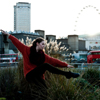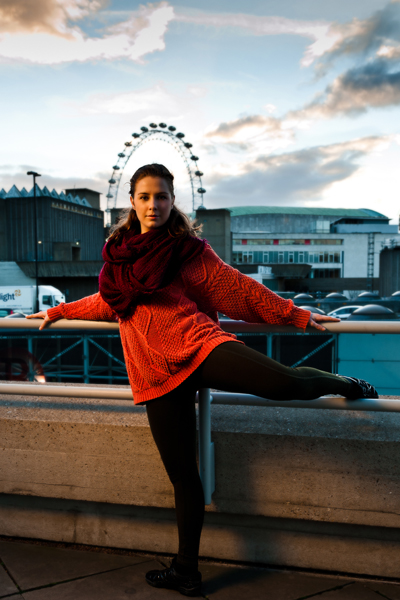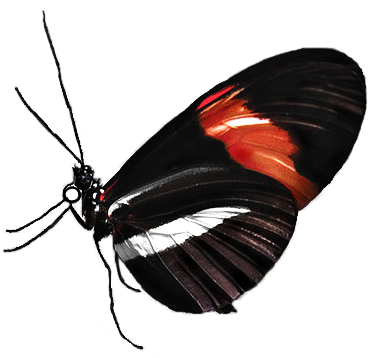
Flow Foster South Bank dance photo shoot
Background
This is my first blog of the year. The test shoot took place on 29th December 2015 and features the fun and fantastic Florence 'Flow' Foster. She is a third year dance student at the Northern School of Contemporary dance in Leeds. She brought along her friend Raphael to assist with the lighting and consumption of bite sized cake. I invited Giulia a fellow photographer I met at the SWPP's (Society of Wedding and Portrait Photographers) convention in January 2015. I thought she might benefit from seeing me work in the field.
The shoot was based on the South Bank in London around dusk. I wanted to feature the iconic London Eye in some of the shots. The trick was finding somewhere with enough elevation to see it clearly and to catch the sun setting. This meant time would be a critical factor. Working around this time gives a photographer a great deal of scope when it comes to lighting. The light is amazing at dusk (if the sky is clear) and after sunset you can incorporate the artificial lighting into your photographs. I have tried something like this before at Clarence Docks in Leeds.
The shoot
With all my shoots, I have a plan in my head. The first thing to do is scope out the venue and find somewhere to shoot from. Then to shot utilising the type of ambient light at the time. In this case, the sun was setting and I wanted to shoot into it hoping for a bit of lens flare and a few rays of light. I got that in this shot.
1. You can see the lens flare just above Flow's head with beams of light eminating from London Eye. I tilted the camera so her arms would be almost horizontal. Monochrome was chosen for the final render because I felt the image was too busy detail wise and removing the colour helped. f/6.3, 1/125s and ISO 200.
2. A Flow changed the pose, I adapt to her. By removing the colour the red buses are not a distinct feature in the frame. Otherwise our attention would be drawn to them. The sun is just setting behind the building. f/6.3, 1/125s and ISO 200.
Flow came up with the dance poses and we threw suggestions to and fro until we were both happy. Once I the shot had been bagged, we moved on.
3. Flow climbed up a wall for this shot. You can see how clear the sky was. There is a small whispy cloud just above her ear. There are some great architectural angles and shapes in this shot as well as the ones she is creating. A Kodachrome 64 film emulation render was used to create the colours. Raphael held the Rapid Box to the left of the shot to throw in little extra light. f/6.3, 1/125s and ISO 200.
Once the sun had disappeared behind the buildings a little extra light was added in using one of my favourite pieces of kit the Westcott Rapid Box fitted to one of my flashguns with an orange gel to simulate a sunset glow. Raphael was charged with looking after this. I gave him a few instructions on how to 'feather' and place the light. The results are below.

5. The London Eye makes a nice halo or head piece for Flow. Here the sunset look is created by an orange gel over the flash head. By making the light from the flash slightly brighter than the ambient, the background becomes darker. The clouds were darkened to make the sky look a little more dramtic. f/6.3, 1/125s and ISO 200.
6. A landscape version of the photograph five with a different pose. Please not the small inverted triangle light on Flow's cheek. This lighting pattern is know is "Rambrant" lighting. Again the clouds were darkened. f/6.3, 1/125s and ISO 200.
7. This is a the same photograph as the previous one. All I did to give it a colder feel was change the white balance to Tungsten. A neat trick I learnt from a pro from South Africa.
8. A different dance move.
9. Flow pulling and making shapes. It was a tricky job for Raphael to place the light above my head so the camera's flash would trigger the overhead flashgun. If we really struggled a radio trigger could have been used.
10. More of a portrait shot. Again I changed the white balance in post processing so Flow skin tone looks fine and the background becomes bluer.
11. This was taken on a stairwell. The softbox had to be removed from the final shot. One of Flows favourites. A nice scissor kick. I took a few attempts calibrating the flashgun's power to produce the correct lighting. f/2.8 (to blur the background), 1/125s, ISO 200.
Once the sun had set I wanted to utilise some of the artificial lights. Flow changed into a sparkly dress. This proved to be case of serendipity. The reflective properties of the fabric lifted the shots reflecting the light into the lens of the camera. I described the first test shot as, "haunting". I showed Raphael and he said, "I see what you mean." So, we went with that.
12. See what I mean? The lights stop the black areas being too empty. I love the way the sky looks. f/4, 1/125s and ISO 200.
13. A little tip when you are taking photos. Switch from landscape to portrait (or vice versa). One of my favourite shots. I love the way the dress brings the whole shot to life.
14. Flow facing the other way. If you make slight changes or variation on the same shot, you can choose which one worked better later and other people will have different opinions.
15. This one utilised the ambient light. This was taken with the camera on a tripod. I should have increased the ISO to increase the shutter speed (derrr!) so the final shot would have been sharper. f/3.2, 1/2s, ISO 200 and +1.7 EV.
As with all my shoots, I am very protective of whoever I am photographing. This is even more so for dancers. If they are cold they can pull a muscle and injure themselves. I asked Giulia to give Flow her coat if we took a short break to change scenes or plan what to do next. There were ideas that I knew I could have tried, but decided not too because it was cold. If we had done this shoot on a warm evening I would have gone for it. Something for next time.
We saw a short tunnel/underpass whilst we were scoping out the area. We all thought it would be good to do something with it later. So we did. I could have done something with my flashguns to make it really creative like lighting Flow from behind, but I chose something simple for the same reasons as above. After a spot of post processing, the end results were pleasing.
16. In the tunnel. I increased the ISO so the background would be lit a bit. f/4, 1/60th and ISO 800 +1.7 EV (I forgot to remove this from the previous shot).
We ended with a few shots of the London Eye with Flow in front of it. I was not allowed to use a tripod so we had to make do with increasing the ISO of the camera.

17. A handheld shot. f/2.8, 1/8s and ISO 4000. +1.7 EV (this time on purpose so Flow would not be too dark).
Technical
I used a full frame camera in manual mode with a 24-70mm lens for most the shoot. A single flashgun triggered by the camera's built-in flash was used with a Westcott Rapid Box attached. The Rapid Box was mounted on the end of a monopod and used like a boom arm. The power of the flashgun was set manually via the camera.
For the tunnel shots a Stofen diffuser cap was used with the head angled at 45 degrees and TTL mode. The camera was placed in aperture priority mode for speed.
For the London Eye shot the camera was also in aperture priority mode.
Post processing
Most of the post processing was done in Lightroom. A bit of cropping, lens correction, gradient filters and applying a few film emulations.
The rest was performed in Photoshop. This was mostly dodging and burning (lightening and darkening specific areas), sharpening the detail, blurring (and the deemphasising detail in the back or foreground) and removing blemishes from the photograph.
Conclusion and thanks
The overall results were pleasing and I was very happy with the results. There are few areas that need improving. This is why we practice so we can iron-out the creases. There were a few shots that Flow wanted, but there was too much movement in the photograph. I tried different ideas to freeze the pose, but to no avail (as I mentioned increasing the ISO would have solved it). We will have another go at a later and much warmer date.
This was the first time I had worked with Flow. She is very good pulling shapes and ones what work with the environment. She is also great fun to work with. A massive "Thank you" to Raphael and Giulia for helping out too.
Please leave a comment below and let me know what you thought of the photographs especially if you are related to Flow or know her well. I would be interested to read your thoughts.
Your thoughts

Please leave any thoughts, comments, questions or just say, "Hi!" (not literally) below. I really do appreciate feedback. E.g. What is your favourite photograph and why?















